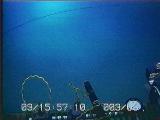 |
The submarine cable was first sighted from Jason lying on top of the
sediment |
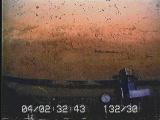 |
After transiting 5 km toward California along the cable, Jason cuts
it using a hydraulic cable cutter attached to its basket. |
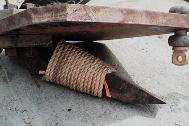 |
After recovering Jason, this grapnel was attached to the end of the
ship's 9/16" trawl wire and used to snag the cable at a point 5 km to the
west of the cut point and bring it to the surface. This operation took
about 24 h and involved very high (up to 20,000 lb) tensions in the wire. |
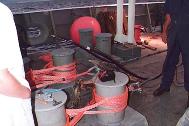 |
The cable was recovered through a chute located on the starboard side
of Thompson and secured to a pair of bitts using special cable grips. It
was then cut, and the end that goes to Hawaii was identified using time
domain reflectometry. |
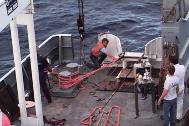 |
The 5 km piece of cable leading to the cut being discarded over the
chute on Thompson. |
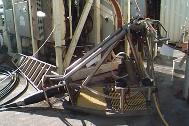 |
The termination frame which was spliced to the end of the cable. This
unit holds an underwater mateable connector which links the junction box
to the cable. |
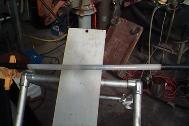 |
The cable splice after connection of the center conductor using a swaged
fitting and overmolding of polyethylene. An outer shield is then soldered
over the polyethylene and the entire joint is protected with an outer shrink
wrap insulator. |
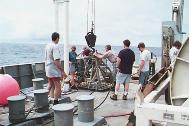 |
The termination frame connected to the submarine cable in the process
of being deployed. |
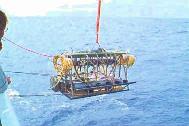 |
The junction box being deployed using the ship's trawl wire. |
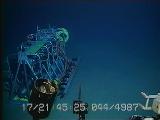 |
The junction box on the bottom viewed from Jason. |
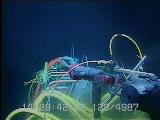 |
The umbilical cable connecting the junction box to the termination
frame being pulled out by Jason. |
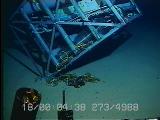 |
The ULF seismometer package resting on the deployment anchor after
being launched as an elevator using glass ball floats above it. The anchor
is disconnected and Jason then picks up the entire unit (which weighs about
40 pounds in water) and moves it to the junction box site. |
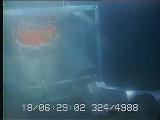 |
The ULF sensor package in its sled being pulled out from the ULF package.
It is then dragged about 10 m away for installation, which requires burial
of the white caisson seen in the picture. |
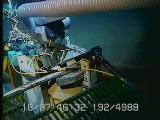 |
Jason pumping sediment out of the caisson using a hydraulic pump.
This operation took about 8 hours and resulted in hole about 2 feet deep. |
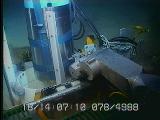 |
The ULF sensor package being installed in the caisson. |